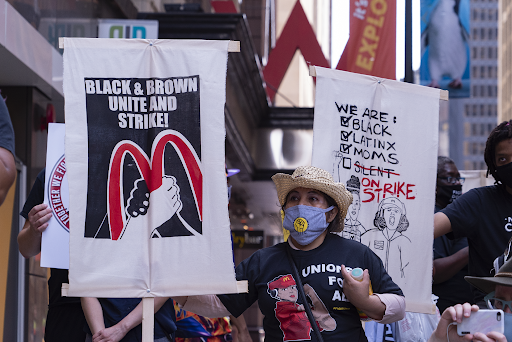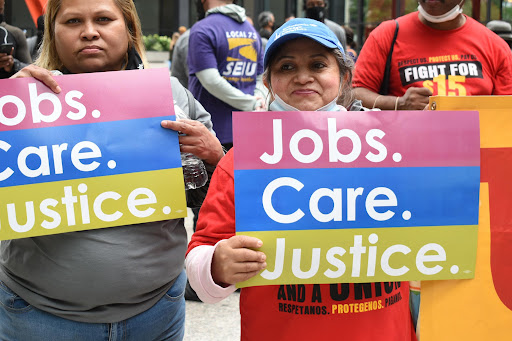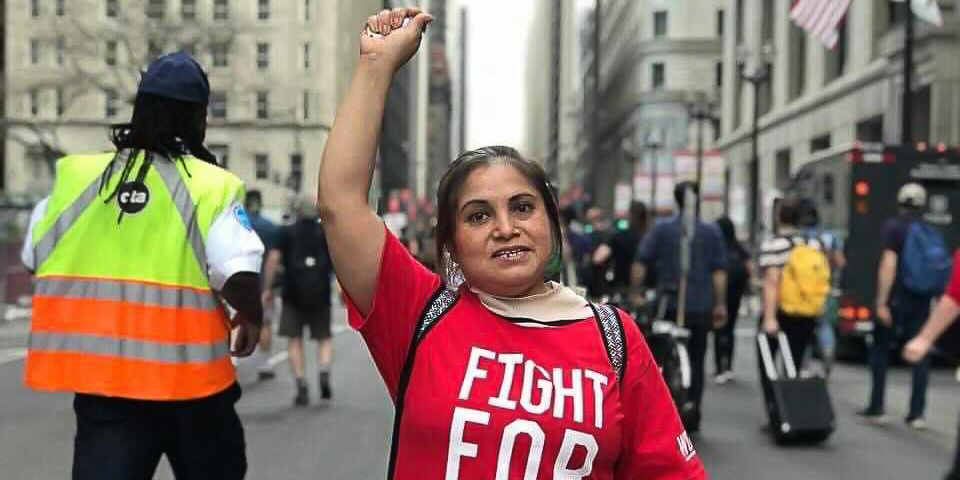The battle for a $15 minimum wage salary proceeds
The word service has a few definitions: the work performed by one that serves, contributes to the welfare of others, or the action of helping or doing work for someone. However, none of them describe encountering discrimination, disrespect or abuse of any kind.
Unfortunately, those in the service industry often have to endure a lot of mistreatment, to the point where it seems crude behavior and disrespect are occupational hazards. But the biggest injustice might be the inadequate pay after difficult days.
Movements and organizations like the Fight for $15 have been around since 2012. It started when 100 fast food workers walked off the job to demand $15/hour plus more union rights in New York City. They’ve managed to expand outside the metropolitan area and reached 300 cities and six continents.
Chicago fast-food worker Teresa Cervantes was approached by members of the Fight for $15, letting her know that she has support if she ever needs it. Cervantes is Mexican and only speaks Spanish but has a translator assist her when doing interviews.
“I started fighting for my rights for minimum wage for union workers and the harassment that’s been going on at the stores and discrimination,” Cervantes said.
Cervantes has worked in the service industry for 33 years. She spent most of her time as a McDonald’s worker. She worked at the former Rock-N-Roll location but is currently employed at the new corporate headquarters location in the West Loop. Her current position is in the lobby area doing clean-up and maintenance work.
During her time at both locations, she faced sexual harassment, discrimination and disrespect on several different occasions. Some incidents happened from customers and others through management.
“I would tell them they were wrong … the mistreatment. But they would say, ‘Your opinions don’t count, you’re here to work,’” Cervantes said.

Photo courtesy of Fight for $15
At times the abuse would get to be too much for her to endure, to the point where she sought out a community center, hoping to find someone she can talk to about her work conditions.
Cervantes never took legal action with any of these incidents — only leaned on the support of her fellow community members. Instead of quitting and finding something new, she kept working — only to receive $14/hour working 30- to 40-hour weeks.
As unfortunate as it is to say, Cervantes’ pay is better than other workers in the service industry. DeiZuna Alston, a server at Pappadeaux Seafood Kitchen, receives an hourly wage that doesn’t come close to $14/hour.
“I think we get $7 an hour, but you don’t see it because you pay out your taxes. So, really, your two weeks’ check can be like $50 to $100. So, you really do depend on those tips,” Alston said.
Alston recalled moments where she served tables with a $100 bill at the end of the night, but would sometimes only receive a tip of $5. Every so often, even those small tips she wouldn’t get to keep to herself.
“Say I make like $300 a night, or $400 a night. Out of that $400 that I made, I would have to tip out about $80. So, I don’t get the full $400 because I have to tip out the host, the bartender, and also the bussers,” Alston said. “If you didn’t make that tip, you still have to tip out, you have to come out of your pocket to tip out.”
Alston worked at Olive Garden and Red Lobster during her college years. She looks back at the $5 tips she would receive during those jobs and realizes she “would not be able to survive off of those tips” today.
At this stage in her life she goes into work with a mindset that she has to make $300 in a night to survive for herself and her daughter. Alston hadn’t heard of the Fight for $15 movement but fully supports what they are doing.

Photo courtesy of Fight for $15
Fight for $15 demands justice for more than fast-food workers. They also support and represent home health aides, airport workers, adjunct professors, retail employees, childcare teachers and underpaid workers everywhere.
The movement’s influence has made enough headway to entice members of Congress to consider raising the minimum wage. Senator Bernie Sanders proposed a bill for the minimum wage to be increased to $17/hour, claiming, “Because of inflation, fighting for a $15 an hour minimum wage is no longer enough.”
Chicago Public School teacher Stacie Ochiltree heard of the movement and felt their goals align with the Chicago Teachers Union.
“I think it’s about equality and the distribution of equality. You know, I work on the South Side. So my challenges as a teacher are going to be different than those of a Northside School. We don’t have the materials, the support, anything like that, and I think that directly ties in with minimum wage and the fight for that,” Ochiltree said.
Other organizations like the Service Employees International Union (SEIU), and Union of Southern Service Workers (USSW) work towards similar goals as Fight for $15.
International President of SEIU Mary Kay Henry attended a demonstration on May 4, 2023, and said that she and other members will be watching “any congressperson, senator or in the House, that dares to say that they are not going to vote yes for Senator Sanders’ bill because they need to be held accountable at the ballot box.”
Current discourse on Twitter indicates there could be a possibility the bill doesn’t get passed or Congress will continue to push back, for reasons service workers don’t understand.
“I think there’s a pushback, because people are stupid,” Ochiltree said. “And they don’t understand that it’s about improving the quality of life, because life is very expensive. And I think that’s a blind spot for a lot of people.”
There’s a lot of uncertainty surrounding the fight for minimum wage. But it’s clear that organizations like SEIU, Fight for $15 and everyday workers like Teresa Cervantes, DeiZuna Alston and Stacie Ochiltree will not stop their pursuit for a better life.
Header Image courtesy of Fight for $15




NO COMMENT